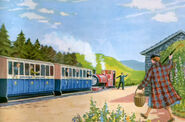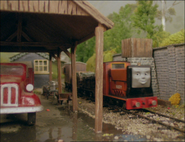- “Have you seen the track at Cros-ny-Cuirn?”
- ― Duncan, Duncan and the Grumpy Passenger, eighteenth season
Cros-ny-Cuirn, (Sudric for "the Ford of the Mountain Ash") is a village and station on the Skarloey Railway. It is located between Crovan's Gate and Glennock.
History
The Railway Series
Some thirty chains beyond the bridge the line climbs sharply before levelling out for the last mile to Cros-ny-Cuirn. This stretch needs to be negotiated carefully as the trackbed has an element of instability which the most careful ballasting has so far failed to correct. It was here that the unwary Duncan came to grief soon after his arrival at Crovan's Gate.
The village stands astride the Ballahoo/Glennock road and east of an ancient ford still marked by Rowan trees. It was regularly used by the Crovan's Gate Mining Company’s pack-horse trains till about 1806, when they by-passed it with a bridge and diverted the road to suit. When, in 1820, the chain of inclines up the valley to Ward Fell replaced the pack-horses, Cros-ny-Cuirn's importance as a transport centre grew, but came to a sudden end with the adoption of steam haulage in 1865. Horses and horse keepers departed, sidings were lifted, stables and wagon sheds were abandoned, and a small unstaffed station with a siding was henceforth enough for local needs. This siding had been so little used during "the lean years" that by 1953, it had become grass-grown and invisible.
The siding was cleared and reinstated soon afterwards as a parking place for Mr. Ivo Hugh’s petrol driven trolley (the first of several; he is currently using Mark V). In 1970 the siding was relaid and extended to make an extra passing loop for use at busy times. Mr. Hugh lives at Cros-ny-Cuirn in a comfortable cottage near the station.
Other inhabitants of the village are farmers and farm workers, with a sprinkling of quarrymen and railwaymen. A few business people from Crovan's Gate and Ballahoo have settled here and commute daily. Sir Handel Lloyd Brown lives here too at The Rowans, a house built by his father on the hillside overlooking the gorge, and from which he has an extensive view over the whole valley.
Just north of the station the line swings over the road. The road was there first, and hugged the river bank; so the railway builders crossed it on the level, hacking and blasting their own right of way from the hillside to the east. Road and rail run side by side for two miles till first the road and then the railway swing west across the river. The level crossing has no gates. This was a sore point with the Sodor Island Council who kept pestering both the present Sir Handel and his father to instal them, but neither saw any necessity. Gates had not been ordered in the Railway's Act of 1864; visibility in both directions is good, and there has never been an accident.
In 1960 however, during road widening works, an incident occurred between a train hauled by Sir Handel and the Council's steam roller. The Council thought that this had given them an opportunity to force Sir Handel’s hand. They sued him, claiming that according to regulations his driver should have stopped dead at the crossing, and they asked for an Order that gates should be erected. Unfortunately for them, Sir Handel had seen the whole incident from his study window. He counter claimed against the Council for the careless driving of their steam roller, and for damages resulting there from. He was moreover able to prove, with the aid of photographs taken at the time by a reporter from the Crovan's Gate Gazette, that not only was his driver not at fault, but that the incident had taken place some distance north of the level crossing. The Council lost their case. Damages were awarded against them, and they were told that if they wanted gates they would have to provide them themselves. This they declined to do, and a certain coolness resulted.
In 1966 however, with the traffic build-up resulting from the Railway’s Centenary publicity, it was found that the statutory level crossing precautions were causing unwelcome delays. Sir Handel therefore approached the Chairman of the Council, and suggested that if they were willing to share the cost, he would be prepared to install a system of train-operated bells and flashing lights. This offer was accepted, and harmony was restored once more.
Where road and rail divide, the road dips sharply, and swings west to cross the river by a hump-backed bridge. The railway, without change of gradient, crosses by a girder bridge. Two miles of lonely moorland follow. It was here that Rheneas came to grief but ”first aid” rendered by Ivo Hugh and the Thin Controller, enabled him to struggle up the last mile and a half to Glennock.
The illustrations seen in Four Little Engines show a bridge near the station, this is incorrect because there is a level crossing on there. The same book shows open country just after the station, but in reality the line runs parallel between the road and a cutting as shown in Gallant Old Engine.
Thomas & Friends
In the television series, the station only appeared in the fourth season. It consists of a single platform with a building. A siding is located here. It was later mentioned by name for the first time in the eighteenth season episode, Duncan and the Grumpy Passenger. The Village Square is located here.
Appearances
The Railway Series
Thomas & Friends
- Season 4 - Sleeping Beauty, You Can't Win, Rock 'n' Roll and Special Funnel
- Season 18 - Duncan and the Grumpy Passenger (mentioned)
Trivia
- Its Talyllyn Railway equivalent is Rhydyronen.
- Cros-ny-Cuirn was originally spelt Crossag-ny-cuirn and had the meaning "little crossing in the mountain ash". The name was proposed by George Awdry. [1]
- In the television series, it was used to represent one of the stations on the Mid Sodor Railway.
Gallery
- ↑ "The Thomas the Tank Engine Man" p.207







